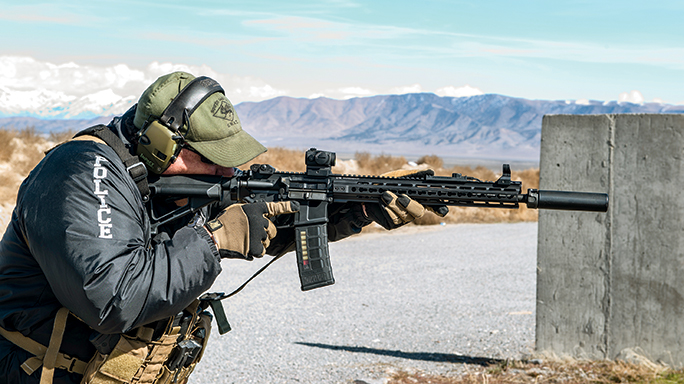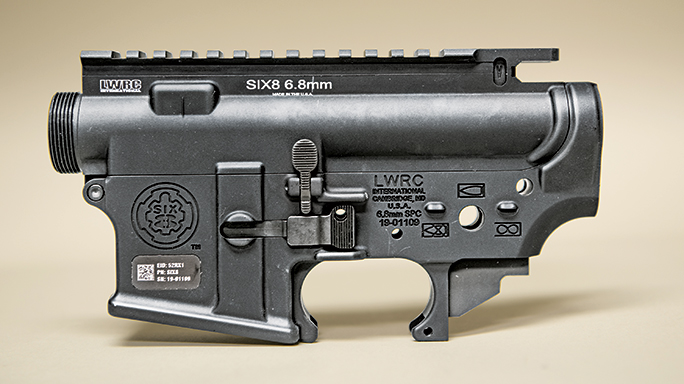A police officer’s workspace is short when compared to a soldier’s, making any argument about the overall ineffectiveness of the 5.56mm NATO cartridge specious to me. It works fine for most. It is convenient, light on recoil and gets the job done. But there are some better alternatives. Rural law enforcement agencies, for example, may need something bigger and faster with more energy on target at longer ranges. Sure, the .308/7.62mm works, but it creates other issues, like cost, overpenetration, weight, perception and reliability in an AR. The 300 BLK is promising, but current ammunition costs are just too high. Cost, coupled with a lack of availability, turned my attention to the 6.8 SPC, and LWRC International provided the perfect opportunity for me to get back into this excellent chambering.
Special Purposes
Using the 6.8 SPC in a standard AR-platform rifle presents a couple issues. Converting from a 5.56mm to the 6.8 SPC requires a bolt and magazine change. Matching the gas tube and barrel length is a bit more critical. Feeding could also be problematic, with longer loads limiting your choices when reliability is paramount. Magazines for the 6.8 SPC have always been the Achilles’ heel; they need to be steel to work, making them heavy, costly and sometimes limited in terms of capacity. Polymer magazines have yet to prove viable, until now.
Advertisement — Continue Reading Below
LWRC International, a longtime supporter of the 6.8 SPC, decided to start over and address these issues, resulting in its line of Six8 rifles. The company collaborated with Magpul from the start, and the latter built a PMAG around the cartridge. Federal also helped by developing ammunition to work with the system that is less costly, accurate and suitable for duty use. The retail pricing on the magazines is about half that of the steel versions—definitely a boon these days.
LWRC built one of its proven lower receivers around this magazine and cartridge. The feeding angles, bolt timing and other issues were addressed. Adding the company’s piston-driven upper resulted in one of the most reliable 6.8 SPC rifles available. Standard uppers would not work, limiting you to a complete gun—at least until recently, that is.
LWRC International is now offering matched upper and lower receiver sets in the Six8 platform, allowing you to build a direct-impingement gun. Many want a simple direct-impingement gun that also features the advantages of the Six8 design, and this is just the ticket.
Advertisement — Continue Reading Below
The Players
Having tested dozens of ARs over the years, a few companies always seem to excel when it comes to simplicity, reliability and usability in a stock build. There are a few, but two that have worked well for me have been Primary Weapons Systems (PWS) and Daniel Defense. Their off-the-shelf rifles worked no matter what I did to them, prompting me to use their parts to finish the build. I used a Daniel Defense cold-hammer-forged barrel and a matching bolt and PWS’ buffer tube, bolt carrier and a 15-inch handguard.
For the gas system, I installed a MicroMOA “Govnah” gas block, which comes with interchangeable plates to control the gas flow. Two- and three-hole plates are available, and they can be moved without tools. Pre-drilled plates are available for some calibers, or you can drill your own. I have one installed on my competition rifle that works well. Given the huge range of ammunition for the 6.8 SPC, I used a three-position plate to customize the gun for suppressed fire.
Advertisement — Continue Reading Below
LWRC’s Six8 lower receciver comes the company’s ambidextrous magazine and bolt release, dust cover, takedown pins and a direct-impingement gas tube guide. Ernie Bray at Red Creek Tactical provided a set of Battle Arms Development (BAD) enhanced pushpins (BAD-EPS). Geissele’s SSA trigger and Troy Industries’ ambidextrous safety finished out the internals. Magpul’s STR stock covered the PWS one-piece buffer tube. A BCM Gunfighter pistol grip and Magpul triggerguard completed the lower. Finally, to help mitigate recoil, I added Sprinco’s Tactical Blue Spring and a Spike’s Tactical T2 buffer.
Duty-Ready Build
Putting an AR together is anything but rocket science. Keep it simple and use quality parts, and things will go together pretty easily. This is one of the things that make this platform so popular. It may be the most user-friendly rifle ever developed. Building this rifle was no different, especially when starting with the LWRC matched set. These receivers are “double coined” forgings, providing CNC detailing with all the strength of a forged receiver. The attention to detail on this set is excellent.
Advertisement — Continue Reading Below
Daniel Defense makes some of the best duty-ready barrels on the market. Cold-hammer forged, they are accurate, easy to clean and consistent. This barrel uses a 1-in-11-inch twist rate and a 6.8 SPC II chamber. The barrel also has 5/8×24 threading and is built for a mid-length gas system with the company’s S2W (Strength To Weight) profile. It fit perfectly in the LWRC upper receiver.
The PWS handguard is designed for DI guns. Measuring 15 inches long, it uses the KeyMod system for attaching accessories. The free-floating handguard cradles the gas tube and a barrel nut threads inside it, attaching the barrel. Once in place, it’s easy to remove the handguard as needed. The matching bolt was placed in the PWS DI carrier. Machined from tool steel, these carriers are incredibly strong. They’re also coated in QPQ for smooth operation. It all came together and worked perfectly and smoothly in the upper receiver.
It’s critical to properly fit the gas block. It must be lined up perfectly for all three holes to work. There is a plug on top of the block that lines up with the porthole. Start by drilling the left-side hole on your plate (muzzle forward) to match the barrel porthole (0.086 inches in this case). Put the plate in the block, install the block on the barrel and use the matching-numbered drill bit to line them up. Tighten the gas block and mark it, or use feeler gauges to measure any gap between it and the block.
Advertisement — Continue Reading Below
Attaching the PWS buffer tube took some work. This tube uses an extended lip to cover the plunger and spring. The LWRC receiver is fractionally longer and is cut so that there is a ledge just past the plunger-tube hole. Careful fitting of the lip allowed the tube to slide in place. Installing the BAD takedown pins was simple; a magnet holds each pin in place. Geissele’s trigger dropped into place, and the Troy Industries safety is excellent. Instead of screws, the levers snap into place—very quick and solid with nothing to come loose.
LWRC equips this lower with a screw, accessed from under the grip, which allows you to tighten the fit between the upper and lower. I tightened it and installed the BCM grip. Next I installed the buffer and spring. Once all together, I tested the rifle’s tolerances and smoothness, and cycled it using snap caps. LWRC’s ambidextrous charging handle is great but a little tight—it broke in nicely after live-fire testing.
Rounds Downrange
Advertisement — Continue Reading Below
Using the initial full-port option on the gas block, I tested the rifle with a variety of 6.8 SPC ammunition, most of it from Silver State Armory. I tested loads ranging from 85-grain Nosler E-Tips to 115-grain OTMs, as well as some of Federal’s new 90-grain Gold Dot rounds and Hornady’s 110-grain V-MAX and BTHP ammo. All of it worked well on this open setting with the exception of the 85-grain E-Tips. The rifle ran well but the bolt would not lock back. Everything else was reliable and ejected between 3 and 4 o’ clock. In fact, this LWRC receiver set is a game-changer for the caliber. Short of a couple custom builds, this is the most reliable 6.8 SPC DI gun I’ve ever tested, and the Magpul magazines are excellent.
For the second range session, I removed the gas plate and installed one with the other two holes pre-drilled at 0.07 inches. I placed the plate in my trailer hitch vise and used a drill to slowly increase the port size until, when installed, the bolt locked back regularly with every round and ejected properly. The center hole ended up at 0.076 inches, reliably firing everything with my SureFire SOCOM762-MINI suppressor attached. The last hole was tuned specifically for use with the 115-grain TAC Loads from Silver State (unsuppressed). Multi-gun matches are a consideration, so this was set up just for that purpose. I tested the rifle for reliability on all three settings with and without the suppressor. My final testing resulted in a 0.086-inch setting for wide open, a 0.076-inch setting for suppressed and a 0.081-inch setting for the 115-grain OTM ammo. All rounds ejected perfectly at 3 to 4 o’clock and were 100-percent reliable. The recoil was also reduced for a very smooth range session.
My last range session consisted of accuracy testing and some drills. I used Bushnell’s Elite Tactical 1-6.5x24mm SMRS scope for the accuracy testing and chronographing. All of the testing was done with the suppressor in place. Groups at 100 yards were impressive, with the Federal 90-grain Gold Dot ammo just short of astounding. In fact, it produced a cloverleaf group measuring just a tad over 0.5 inches. Everything else shot at or around an inch. Moving to an Aimpoint T-1 and an HK fixed front sight, I performed a number of drills, and the rifle ran without a single issue.
Advertisement — Continue Reading Below
Smooth Operator
This was one of the smoothest AR builds I’ve ever completed. LWRC’s receiver set was tight, and I experienced no installation problems. Coupled with the Daniel Defense barrel and PMAGs, it was reliable, accurate and well balanced. I would encourage anyone looking to built their own 6.8 SPC AR to give this setup a close look.
MicroMOA’s gas block allows for incredible versatility in a DI gun. Once set up, you just push the plate back and forth. If you want to alter it, remove the plate, drill it and replace it, or simply have a couple of plates for various needs. It was perfect for this build, providing versatility with a wide range of ammunition. It is solid and stayed in place throughout the testing.
Advertisement — Continue Reading Below
- RELATED STORY: Gun Review: LWRC International’s Six8 SBR
I’m going to use this rifle at police department trainings as well as a couple of schools, and maybe even a competition or two. One thing is for sure: The LWRC matched receiver set is well built with solid attention to detail. It allows you to get the most from this chambering.
More Information
- Aimpoint: aimpoint.com; 877-246-7646
- Daniel Defense: danieldefense.com; 866-554-4867
- LWRC International: lwrci.com; 410-901-1348
- MicroMOA: micromoa.com; 407-900-9591
- Primary Weapons Systems: primaryweapons.com; 208-344-5217
































